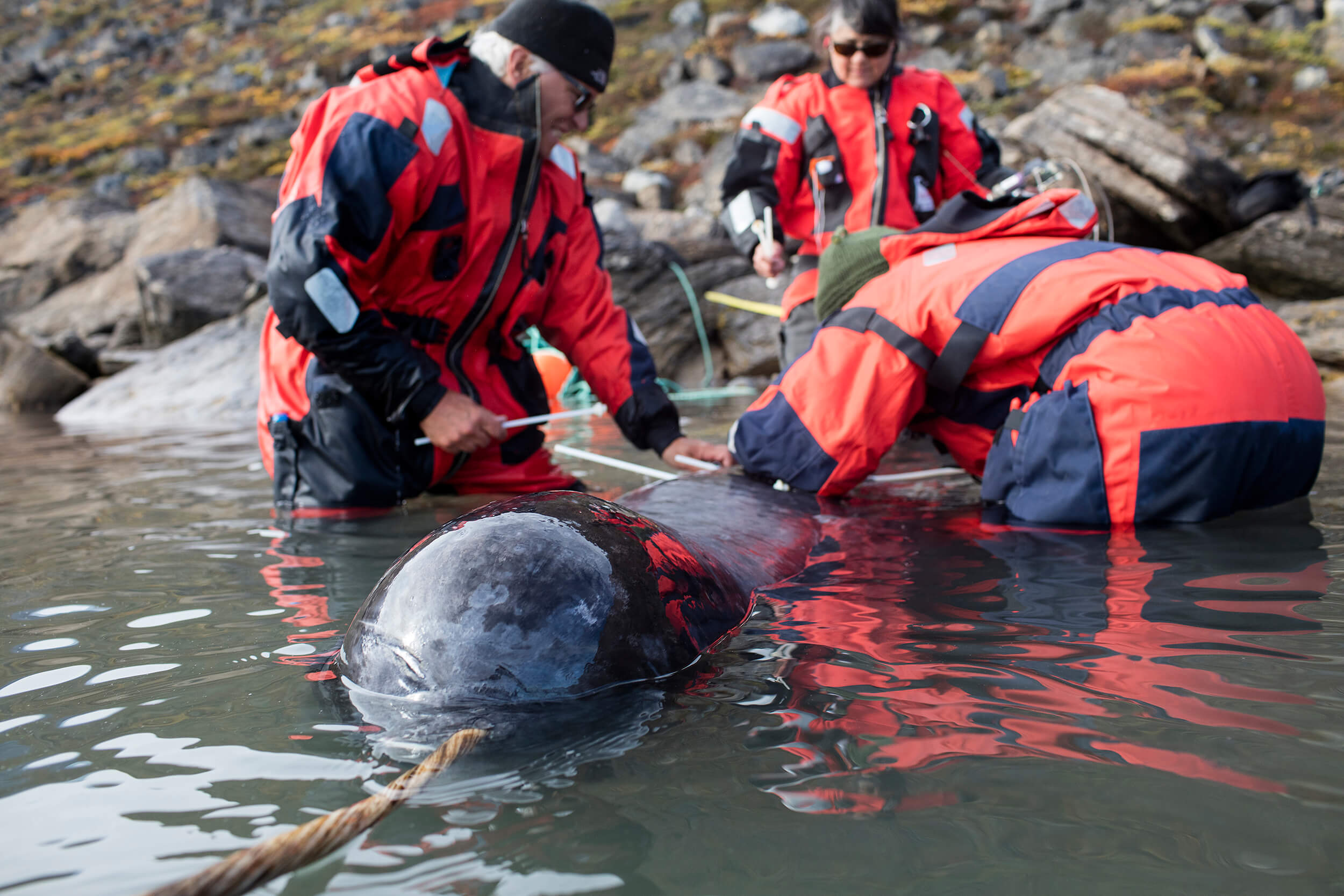Number cruncher calculates whether whales are acting weirdly
We humans can be a scary acquaintance for whales in the wild. This includes marine biologists tagging them with measuring devices to understand them better. These experiences can make whales behave erratically for a while. Such behaviour can affect research quality and highlights an animal ethics dilemma. Now, University of Copenhagen researchers have figured out how to solve the problems with math.

Maybe you have tried taking a howling pooch or cranky cat to the vet. Regardless of your noblest intentions, your pet’s experience may have been equally unpleasant. Animals react to the unknown in their own way. The case is no different for cetaceans like narwhal and bowhead whales when they encounter human generated noises such as ship noise or mining blasts in the North Atlantic – or when they are caught by well-meaning marine biologists who just want to get to know them better.
When biologists ‘tag’ whales with measuring devices, the animals react by behaving unusually – abnormally. For example, for a while after being tagged, they may perform many atypical shallow dives and quick jerks. Such behaviour is misleading when the goal is to study the animal’s normal and natural behaviour.
The problem is getting help from an unusual corner.
"Biologists seek to understand animals as natural beings, but their reactions turn into unnatural behaviour that creates noise in the dataset. Because of this, a lot of data from just after whales are tagged ends up getting discarded. In this study, we have proposed a mathematical approach using statistical methods that can determine exactly how much data to keep," says PhD student Lars Reiter from the Department of Mathematics.
Valuable for humans and animals alike
With two statistical calculations, the researcher has found a way to estimate when whales like narwhals and bowhead whales will return to their natural behaviour after being tagged. It is a method that can also be used to study how animals respond to other types of disturbances.
"This research is extremely valuable to us as marine biologists who are interested in the behaviour and well-being of whales. It provides us with a standardised approach by which to distinguish between natural behaviour and affected behaviour in whales. Thus far, we’ve made individual estimates that are more or less spot on," says marine biologist Outi Tervo from the Greenland Institute of Natural Resources, who collaborated with the mathematicians on the study.

Photo: Carsten Egevang, Greenland Institute of Natural Resources.
The statistical method allows researchers to avoid discarding too much or too little data. If too much data is kept, it can interfere with the research results, and if too much is lost, it comes at cost to both the animals and humans.
"It really matters in terms of research, but also financially. And not least, it means something for animal welfare. If we throw away data unnecessarily, more whales will eventually have to go through the experience for us to conduct this research, which is ultimately meant to benefit the animals," says Outi Tervo.
An important instrument for a future with less ice and more people
The natural Arctic habitat of narwhals and bowhead whales is changing due to climate change. Annual ice shrinkage and increasing human activity is taking place in areas that whales once had all to themselves. The researchers' method can become an important instrument and contribute to a greater understanding of the consequences.
"It allows us to study how whales are impacted by various human activities. They can be external sources of noise that we can situate in time and location, such as a blast or a ship passing by. Or sounds and activities that we emit ourselves. Lars' algorithm lets us get a clear picture of how it all affects the animals," says Outi Tervo.
Increased activity will lead to more ocean noise, which is of concern to marine biologists with regards to how it will affect large marine animals like narwhal, which are incredibly sensitive to sound. Co-author and supervisor Professor Susanne Ditlevsen believes that the studies and new method will become more important in the years ahead.
"Climate change is leading to increased anthropogenic activity in Arctic whale habitats. Melting ice means that areas which were once impassable can now be reached by humans. We would like to assess whether it scares and disturbs the animals, but it is not clear how. The new methods can be used to assess at what distance from the animal habitat should various activities take place," says Susanne Ditlevsen.
Idea came from a parliamentary election
Whale behaviour does not go from abnormal to normal with a flick of its tail. Their behaviour normalizes gradually, typically over a day - and in a few cases over a longer period of time. During this transition, a whale's behaviour manifests itself on both sides of an area designated as normal whale behaviour. So how do scientists figure out where to make the cut?
"The idea came to me while I was standing in the voting booth during parliamentary elections. Borrowing from the logic of the electoral system, you can consider it as if the whales – or these data points which show the whale's behaviour – vote on whether they are in or out of their normal range," explains Lars Reiter.
By recording 1 positive "vote" when the behaviour is within the normal range, and 1 negative "vote" when outside, the scientists can add up all the votes and find the moment at which the number of votes goes from predominantly negative to positive.
The researchers use two approaches to determine normal whale behaviour. In part, they look at the whale's diving pattern, as well as its acceleration and fine motor skills.
How to calculate the behaviour of animals statistically
Sometimes it hunts in the deep, while at others times, it cruises quietly at the surface. The activity that a whale is engaged in is crucial for understanding its normal energy level. Lars Reiter's method takes this into account as something new:
"Where previous research focused on the mean behavior, we instead situate a whale in an activity based on its movements - where it is assessed based on a normal value for acceleration that matches the specific activity being engaged in. We do this by using what are known as quantiles, instead of averages, because they allow us to focus on behavioural extremes. For example, hunting and resting are opposing extremes in terms of energy levels," explains Lars Reiter.
When the focus is on the whale's diving profile, on the other hand, you look at the pattern formed by the whale's overall activities. By combining depth and time, one can assess whether the distribution of different dive types is natural.
Wiser about the animals' hardships and better at avoiding them
According to the marine biologist, the data-based approach represented by the statistical method also means that researchers can now develop better, more gentle ways of tagging.
"Based on this study, we already know that the amount of time we spend putting the equipment on is an important factor for how much the animals are affected afterwards. Therefore, we can set up some time limits – where we stop and set the whale free if it takes more than X number of minutes allowed,” says Outi Tervo.
A shift away from individual estimates to a mathematical standard could also mean better assessments from the veterinary oversight that tag-using research projects are required to go through.
"The method will make it so that ethical approval from a veterinary inspection is more data-based and precise. So, there is no doubt that this research is a step forward for animal welfare," says the marine biologist.
The study is part of a larger research collaboration between the Greenland Institute of Natural Resources and the University of Copenhagen’s Department of Mathematics, that focuses on the Arctic's large marine mammals.
The researchers include Lars Reiter Nielsen and Susanne Ditlevsen from the University of Copenhagen, Outi M. Tervo and Mads Peter Heide-Jørgensen from the Greenland Institute of Natural Resources and Susanna B. Blackwell from Greeneridge Sciences, Inc., Santa Barbara, USA
Contact
Lars Reiter Nielsen
PhD student
Department of Mathematical Sciences
University of Copenhagen
+45 35 32 43 30
lrn@math.ku.dk
Susanne Ditlevsen
Professor
Department of Mathematical Sciences
University of Copenhagen
+45 35 32 07 85
susanne@math.ku.dk
Kristian Bjørn-Hansen
Journalist and Press Contact
Faculty of Science
University of Copenhagen
+45 93 51 60 02
kbh@science.ku.dk
